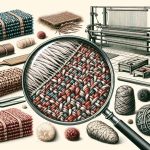Identifying genuine tweed has always intrigued me, especially given its rich history and distinct characteristics. When I pick up a piece of tweed, I first notice the texture—it's usually rough, but there's a subtlety in the weave that speaks volumes about its craftsmanship. The colors and patterns aren't just random; they tell stories of their origins. What really sets tweed apart, however, are the intricacies of its weave. I've often wondered how much we can actually tell about a tweed garment just from a cursory glance. What deeper qualities can we uncover with a more thorough examination?
Table of Contents
Key Takeaways
- Check the fabric texture; authentic tweed has a rough, dense feel with a tight weave.
- Examine the color patterns; look for earthy tones and intricate, multicolored specks.
- Look for a label indicating origin, such as "Harris Tweed," which verifies authenticity.
- Assess the fabric's resilience by pinching it; genuine tweed should bounce back.
- Inspect the weave for irregularities, as true tweed often shows slight variations due to its handwoven nature.
Origins of Tweed Fabric
Tweed originated in Scotland and Ireland as a durable fabric for outdoor wear. Its development wasn't just a fashion evolution; it was a response to the harsh, unpredictable weather typical of these regions. The fabric's tight weave and thick material provided necessary protection against the cold and damp, making it ideal for farmers, hunters, and fishermen. This practical origin underscores its historical significance.
The cultural impact of tweed is equally profound. Initially, the patterns and colors of tweed varied distinctly between different estates and regions. This variation wasn't merely aesthetic but served a practical purpose. It helped identify the wearers' origins and affiliations, almost like a clan tartan. Over time, tweed became synonymous with the rustic elegance of the British countryside, emblematic of a lifestyle that celebrated outdoor pursuits.
As tweed's popularity grew, it transcended its utilitarian roots to become a staple in fashion, admired for its durability and style. It's fascinating how a fabric, born out of necessity, shaped not only the identity of a region but also influenced broader fashion trends worldwide. Understanding its origins enhances our appreciation of tweed's enduring appeal.
Characteristics of Genuine Tweed
Understanding the origins of tweed helps us appreciate what sets genuine tweed apart in terms of its unique characteristics. When I'm examining a piece of tweed for authenticity, I look for several tell-tale signs. To begin with, the texture is key—it should feel rough to the touch. This roughness is a sign of the traditional weaving techniques used, often done on looms that give it a distinctive, non-uniform look.
Tweed's durability is another hallmark of its authenticity. Genuine tweed is renowned for its ability to withstand wear and tear, making it a favorite for outdoor activities. The fabric's tight weave contributes to its strength and longevity, qualities you can actually feel when you handle the material. If it feels too lightweight or flimsy, chances are it's not the real deal.
Moreover, true tweed has a complex color pattern. The colors aren't just printed on the surface; they're woven into the fabric, creating a depth of color that can't be replicated by simple dying processes. This depth adds to the fabric's overall appeal and authenticity. Each piece of genuine tweed is unique, reflecting the artisanal skill behind it, ensuring that no two pieces are exactly alike.
Types of Tweed Explained
Why should you know about the different types of tweed? Well, understanding the varieties helps you pick the perfect fabric for your needs, whether it's durability, style, or authenticity you're after. Here's a quick guide to the types of tweed:
- Harris Tweed: Known for its Harris popularity, this type is handwoven by islanders in the Outer Hebrides of Scotland. It's famous for its exceptional quality and durability, making it ideal for outerwear. Harris Tweed is also protected by law, ensuring each piece is authentically crafted.
- Donegal Tweed: This Irish tweed is celebrated for its unique Donegal distinctions, which include a rough texture and a blend of colorful specks. It's traditionally made from wool and is perfect for those who love a pop of color and a touch of tradition in their wardrobe.
- Shetland Tweed: Made from Shetland sheep wool, this type is softer and lighter than most other tweeds. It's great for more delicate items like fine jackets or scarves.
- Saxony Tweed: Originating from Saxony in Germany, this tweed is known for its smooth feel and fine texture, making it suitable for high-end suits and formal wear.
Understanding these types can help you make an informed choice and appreciate the craftsmanship behind each style.
The Weaving Process
Let's explore how tweed is woven, a process that combines tradition with intricate craftsmanship. At its core, the weaving process for tweed involves transforming raw wool into a durable, textured fabric. Various weaving techniques come into play, each contributing to the fabric's unique characteristics.
First, the wool is spun into yarn. It's then dyed, often using multiple colors to achieve the desired depth and complexity in the tweed's appearance. Once ready, the yarn makes its way to the loom. There are several loom types used in tweed production, but traditional wooden handlooms and modern mechanical looms are the most common.
On a handloom, the process is labor-intensive but allows for greater control over the weave. This method is essential for creating intricate patterns such as herringbones and checks. Mechanical looms, on the other hand, offer more speed and efficiency. They handle larger volumes and maintain consistent quality, which is important for meeting higher production demands.
Each loom type contributes uniquely to the texture and tightness of the weave, influencing the final feel and appearance of the tweed. Mastering these elements is essential for anyone looking to understand or produce high-quality tweed.
Regional Variations in Tweed
Across regions, tweed displays unique characteristics influenced by local traditions and materials. I've seen firsthand how these regional variations not only add richness to the fabric but also tell a story about the people and places behind them. Understanding these differences is key to appreciating the cultural significance and craftsmanship of tweed.
Here's a breakdown of how regional influences shape tweed:
- Harris Tweed from Scotland: Known worldwide, this tweed must be handwoven by islanders in their homes in the Outer Hebrides. The local production methods and legal safeguards secure a product of exceptional quality and authenticity.
- Donegal Tweed from Ireland: Famous for its colorful slubs and a rough texture, this tweed uses locally sourced wool, reflecting the rugged Irish landscape. Each piece connects directly to its Irish roots through unique patterns and hues.
- Welsh Tweed: Often heavier, Welsh tweed is influenced by the need for durable and warm fabric against the chill of the Welsh hills, utilizing local wool in a way that emphasizes practicality and endurance.
- English Tweed: Typically finer and softer than its Celtic counterparts, English tweed often incorporates more urbane and sophisticated designs, suitable for city wear as well as country attire.
Each type of tweed holds its own story, deeply embedded in local traditions and environmental necessities.
Identifying Quality Craftsmanship
When I look at tweed, the first thing I check is the material and how it's woven. Good craftsmanship shows in the details, so I closely examine the stitches and finish.
These aspects can tell you a lot about the quality and durability of the fabric.
Material and Weave Analysis
Examining the material and weave is essential for evaluating the quality of tweed craftsmanship. When I'm looking to identify high-quality tweed, I focus on several key aspects:
- Fiber Density: The tighter the fibers are packed, the better the durability and feel. High fiber density often indicates superior quality.
- Weave Complexity: Traditional tweeds have intricate weaves that add to their unique texture and pattern.
- Touch and Feel: Quality tweed should feel substantial yet flexible. If it's too stiff or too loose, it mightn't be the best.
- Manufacturing Locales: Tweeds from renowned locales like Scotland or Ireland usually maintain a higher standard in the textile industry.
Understanding these elements helps me discern true quality in tweed fabrics.
Stitch and Finish Examination
Examining the stitching and finishing touches to gauge the craftsmanship of the tweed is crucial. One must also assess how the fabric holds up. Fabric resilience is paramount. A well-crafted tweed should bounce back when pinched, showcasing its quality. Additionally, checking the thread count is important; a higher count often indicates a smoother and more durable fabric.
Moving forward, closely scrutinizing the stitches is necessary. They should be even and tight. Loose or uneven stitching may suggest poor quality. Furthermore, the seams and hems need to be neatly finished, free of fraying or stray threads. This meticulous attention to detail in the finishing speaks volumes about the craftsmanship.
Textural Differences in Tweed
As we explore textural differences in tweed, it's important to understand the variety of weave patterns. Each pattern not only affects the look but also the feel of the fabric.
We'll also look at how different fiber contents can change the texture and durability of tweed.
Identifying Unique Weave Patterns
Tweed's unique weave patterns create distinct textural differences that are key to its identification. I've learned to look for specific characteristics that set apart the quality and authenticity of tweed:
- Thread count comparison: Higher thread counts usually indicate finer, denser tweed, which often translates to better quality.
- Durability testing: By examining how the fabric holds up under stress, I can judge its durability.
- Pattern clarity: Clear, consistent patterns without blurring are signs of well-woven tweed.
- Feel of the fabric: Roughness or smoothness can vary; this tactile quality helps pinpoint the type of tweed.
Understanding these elements has sharpened my ability to distinguish between various tweeds, enhancing my appreciation for this robust material.
Exploring Fiber Content Varieties
Exploring the varieties of fibers used in tweed reveals significant textural differences that enhance its unique characteristics. Traditional tweed primarily uses wool, but other fiber sources like cotton and silk are also incorporated to achieve specific textures. These natural fibers provide the softness and warmth tweed is known for.
On the other hand, some modern tweeds include synthetic blends. These are often introduced to improve durability and reduce costs. The addition of synthetic fibers like polyester can alter the feel, making the fabric slightly stiffer but more resistant to wear and tear. It's fascinating to see how the choice of fiber influences the overall quality and application of the tweed fabric.
Assessing Surface Texture Feel
Moving beyond fiber content, I'll now assess how different tweeds feel to the touch, noting their textural distinctions. Here's a tactile comparison to guide you:
- Softness: Some tweeds are surprisingly soft, ideal for clothing that directly touches the skin.
- Roughness: Others have a coarser feel, which speaks to their rugged durability and traditional use in outerwear.
- Thickness: Pay attention to the thickness of the fabric. Thicker tweeds typically offer more warmth and fabric resilience.
- Flexibility: Check how the fabric drapes. More flexible tweeds are often more comfortable but might be less resilient in harsh conditions.
These aspects help you understand and appreciate the practical and aesthetic qualities of tweed.
Color Patterns and Significance
One must appreciate how the color patterns in tweed not only enhance its aesthetic appeal but also signify its origins and uses. These patterns often reflect the traditional dyeing techniques unique to the region where the tweed was made. For instance, natural dyes derived from local plants and minerals create distinct, earthy colors that are immediately recognizable.
Tweed colors also follow seasonal trends. Designers might introduce brighter hues in spring collections while opting for muted, warm tones in autumn. This sensitivity to seasonal changes guarantees that tweed remains fashionable yet functional year-round.
Understanding these patterns helps you appreciate tweed's versatility and craftsmanship. It's not just about the visual impact; it's about the story woven into the fabric. Each pattern can hint at the landscape it comes from, whether it's the greens mirroring Scottish hills or the grays reflecting the ruggedness of the Hebrides.
Care and Maintenance Tips
Now that we've looked at how to identify tweed by its color patterns, let's talk about keeping it in great shape.
I'll show you how to clean tweed properly, store it safely, and fix any damage it might have.
These steps will help your tweed garments last longer and look their best.
Cleaning Tweed Properly
To keep your tweed looking its best, regular and careful cleaning is essential. Here's a simple guide I follow:
- Dry Cleaning Specifics: Always check the label, but typically, tweed should be dry cleaned. This preserves its texture and prevents shrinkage.
- Brush Regularly: Weekly brushing removes surface dirt and keeps the fabric neat. Use a soft garment brush.
- Stain Removal Tips: Blot spills immediately with a clean cloth. For stubborn stains, I recommend taking it to a professional rather than risking home remedies.
- Freshening Up: Between cleanings, air out your tweed. Avoid prolonged sun exposure, but a little fresh air does wonders.
This routine keeps my tweed garments in excellent condition, ready for any occasion.
Storing Tweed Safely
After cleaning your tweed, it's important to store it properly to maintain its quality. Climate considerations play a vital role. I always make sure my storage area is cool and dry to prevent the fabric from becoming musty or moldy. Humidity can be a real enemy of tweed.
For pest prevention, I use natural repellents like cedar blocks or lavender sachets. These keep moths away without the harsh smell of mothballs. I also ensure to check my tweed regularly for any signs of pests.
I hang my tweed garments in breathable garment bags and leave space between them to ensure proper air circulation. This method prevents creasing and provides additional protection from dust and pests.
Repairing Tweed Damage
If your tweed gets snagged or torn, don't panic; I've got some simple repair tips that can help. Mastering the art of fixing your favorite tweed requires attention to detail and the right approach. Here are my top strategies:
- Assess the Damage: Look closely at the tear to understand its size and location.
- Choose the Right Thread: Select a thread that matches the color and thickness of your tweed.
- Master Patching Techniques: Cut a patch that blends seamlessly with the original fabric. Make sure the edges are frayed to merge well.
- Stitch Carefully: Use a needle that won't leave noticeable holes and stitch from the inside to conceal the repair.
These steps guarantee your tweed looks as good as new!
Where to Buy Authentic Tweed
You can find authentic tweed in specialty fabric stores, local boutiques, and online retailers that specialize in traditional textiles. Online retailers offer a vast array of options, often with detailed descriptions and images that help you verify authenticity. They're important, allowing you to shop from anywhere. However, it's essential to check customer reviews and return policies before making a purchase to make sure you're getting genuine tweed.
Local boutiques and specialty shops often provide the advantage of physically handling the fabric. You can feel the texture and see the quality up close, which is essential for recognizing real tweed. These shops typically have knowledgeable staff who can provide insights into the tweed's origin and craftsmanship.
Don't overlook vintage shops. They can be treasure troves for finding unique, high-quality tweed items. Vintage tweed often carries a history and character that newer fabrics can't match. When shopping in vintage stores, inspect the tweed closely for authenticity and condition. Knowing the distinctive characteristics of tweed, like the weave patterns and material composition, will help you make informed decisions.
Wherever you choose to shop, educating yourself about tweed will enhance your ability to select authentic pieces that are perfect for your needs.
Frequently Asked Questions
Can Tweed Fabric Cause Skin Allergies or Irritation?
Yes, tweed fabric can cause skin allergies or irritation, especially if you're sensitive to wool. The rough texture often triggers allergic reactions and irritation. It's best to test wear if you're unsure.
Is Tweed Suitable for Summer Clothing?
I wouldn't recommend tweed for summer clothing due to its low breathability and heavy nature. While its color versatility is appealing, it's better suited for cooler weather to avoid discomfort and overheating.
How Does Tweed Impact Environmental Sustainability?
I've found that tweed's sustainability depends on the use of natural materials and sustainable farming practices. Opting for ethically sourced wool supports environmentally friendly methods, reducing the overall impact on our planet.
Are There Vegan Alternatives to Traditional Tweed?
Yes, there are vegan alternatives to traditional tweed. These synthetic options mimic tweed's composition using materials like recycled polyester, which doesn't involve animal products and often has a lower environmental impact.
Can Tweed Be Recycled or Upcycled Effectively?
Tweed can be recycled or upcycled, but there are challenges. Repurposing tweed requires careful handling to maintain its quality. I've found that creative projects like making bags or pillows are effective ways to reuse tweed.
- Tetron Fabric for Marine Applications: Durability and Use Cases - June 18, 2025
- Tetron Fabric for Outdoor Furniture: Weather Resistance and Care - June 18, 2025
- Tetron Fabric for Wall Coverings: Style and Application Tips - June 18, 2025







